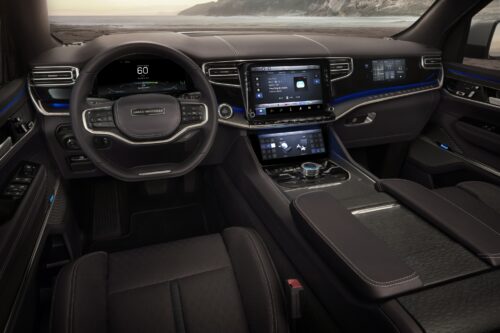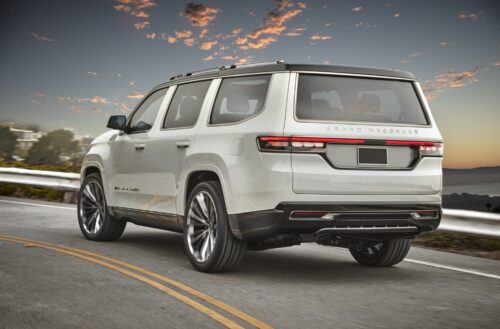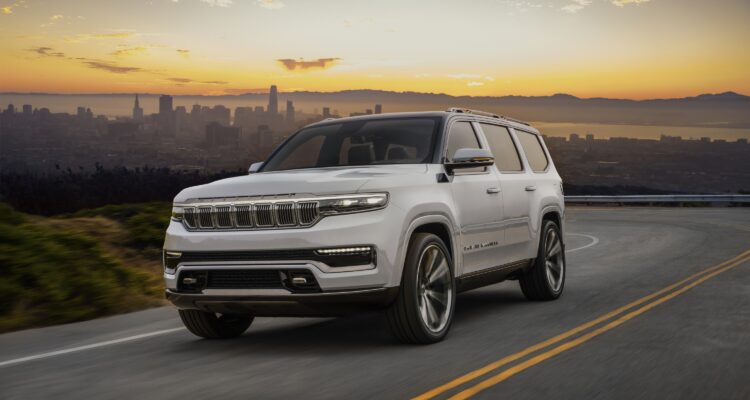It was about 55 years ago – 1962, to be exact – the Jeep Wagoneer first arrived on the scene and essentially changed the automotive landscape forever – just not right away.
You see, Jeep claims that the Wagoneer was a pioneer in the modern SUV space, mainly because it was the first time we’d seen a four-wheel-drive vehicle mated to an automatic transmission. Those were a bit of a luxury back then and as a result, big selling points for the Wagoneer.
About 20 years later, the Grand Wagoneer arrived and took things a step further into the luxury realm by adding leather upholstery, air conditioning (man, premium luxury sure looked quite different in the early ‘80s), AM/FM/CB – no, not “CD”, but “CB”; think “trucker”, not “DJ” – and a jump in power.
The thing is, the greater populace in Canada and the US were still turning mainly to station wagons for their people-moving needs, as the SUV and minivan segments were kind of still in their early days. So once again, the Wagoneer/Grand Wagoneer was a bit ahead of its time.

Things are a little different this time around but also the same in that once again, the Grand Wagoneer Concept is more than just a new vehicle; it’s the harbinger of a whole new portfolio of vehicles that will establish a luxury line-up for Jeep. Think the Range Rover line of Land Rover vehicles. That’s why any allusion to the “Jeep” name is found only in “easter eggs” sprinkled throughout the cabin.
“If you’ll notice,” said Ralph Gilles, head of design at Jeep, “it doesn’t say ‘Jeep’ anywhere on this vehicle. That was on purpose, because we believe Wagoneer represents a new arm for Jeep, a new arm of luxury so we can do things we couldn’t justify on a regular Jeep.”
Indeed, when the Wagoneer brand eventually debuts next year, the vehicles will be available in Jeep showrooms but customers looking for a Wagoneer will get a slightly different buying experience than they would were they looking for a “regular” Jeep.
“Wagoneer will have its own entity, its own flavour,” said Christian Meunier, Jeep global president. “We will have sales people that will know the product very well, and there will be ambassadors for Wagoneer.”
That means luxurious exterior touches like obsidian black grille and 24” wheels with acrylic centre caps, LED lights sprinkled throughout the front fascia (and some teak wood, too – that’s all the wood you’re going to get, though, as there are no plans for any wood side panels à la classic Wagoneer), aluminum “Wagoneer” badging with copper accents and full-length moonroof. The overall proportions are very two-box-like, but modernity is added with rounded corners. While we’ve only had the chance to view the vehicle on the small screen, we imagine it would have some amazing presence.
Thing is, though, while it will get flagship status, the shared details with the original Grand Wagoneer are few and far between; they extend to the seven-slat grille and that’s pretty much it.
According Meunier, though, that’s kind of the point. “We didn’t go the retro route,” he says, “because the expectations of the customer in the large SUV segment is different than it was in the ‘60s.”
Which is why inside the Grand Wagoneer you’ll find six digital displays – one behind the steering wheel, one ahead of the front passenger, two to form the centre stack and one for each passenger sitting in the second of three rows – that combine for a total 84” of display area. The display in front of the front passenger, meanwhile, can be “swept” to the driver so the passenger can set the navigation system and send it the driver’s way.

Displayed on the screens is FCA’s new Uconnect 5 infotainment system, that’s five times as fast as the previous system, and it connects you to an available McIntosh sound system that sports 23 speakers designed to work best inside the Grand Wagoneer as well as speaker grilles finished in real aluminum.
Speaking of “real”: the leather seat, door panel and dash elements you see? Not real leather. Sustainability is important to the Wagoneer brand so a synthetic material called “PUR” covers those areas. The suede-look material seen on other parts of the cabin is also made from synthetic material, but it takes it to the next level by being fully recyclable. It’s a similar story for the Thrive fiber used for the carpets, although it’s the opposite in that it’s made from recycled materials as opposed to just being made of materials that can eventually be recycled.
Speaking of sustainability: it should come as little surprise that the Grand Wagoneer will get a plug-in hybrid-electric (PHEV) powertrain. No figures have been revealed, but there is a charge-percentage display on the front fender and a reported 10,000 lbs. towing capacity.
That alone is a big step for Jeep (slightly less so now that a PHEV Wrangler is right around the corner), and it’s steps like that that need to be taken by Jeep because Meunier has big ambitions for the brand.
“We used to be number one because there was no one else,” he said of the original Wagoneer. “The ambition is to be number one over the long term.”
We’ll be watching closely next year as the Grand Wagoneer begins to arrive in showrooms, possibly with a six-figure price tag considering all the luxury on-board and the advanced powertrain.



